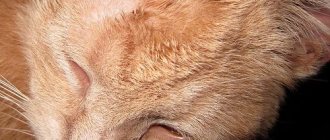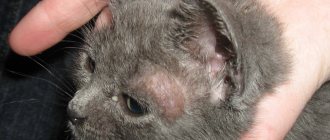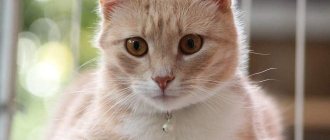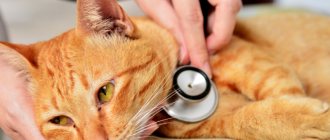Ringworm in animals is very common. Both animals that go outside for walks and those that permanently live at home are at the same risk.
Therefore, it is very important to know the description and signs of this disease, and to know how to cure ringworm in cats in order to be able to help your four-legged friend in time.
What is ringworm
Ringworm (otherwise known as microsporia, trichophytosis) is a contagious fungal disease characterized by skin lesions.
Sources of infection are other sick animals. Transmission factors are any surface or object, even food, that has previously been touched by a sick animal.
Dermatophyte fungi reproduce by spores that remain viable for two years.
The incubation period lasts up to three months. The pathogens take root on the skin of the animal, feeding on the epithelium.
The disease primarily appears on the head, tail and paws. It spreads throughout the animal's body rapidly.
The advanced form of the disease is called generalized. This stage develops when the cat is treated incorrectly or completely untreated.
This disease affects adults with weak immunity, kittens up to one year old, and artificially raised breeds that do not have immunity to lichen.
If your pet has a strong, healthy body, the disease may be easier or it may become a carrier of the disease.
But even with a slight decrease in immunity, the development of ringworm is possible.
When treating microsporia, it is important to identify the underlying disease, which suppresses the animal’s immunity and prepares the ground for the progression of fungi.
Types of shingles infection
When prescribing treatment, it is necessary to understand what type of lichen your pet has become infected with.
There are several types of this infection:
- Lichen planus. A peculiarity of this type is the appearance of red blisters on the skin that itch and burst. The places where these bubbles appear are considered to be the groin area, the abdominal area and the bends of the joints. Lichen ruber is not contagious and therefore cannot be transmitted to humans.
- Pink (shingles) lichen. When infected with this species, the cat begins to develop small pinkish spots on the skin. These spots crust over and then peel off, causing severe itching.
- Eczema (wetting lichen). An extremely rare type of this infection, in which red, very painful blisters with liquid form on the skin.
- Pityriasis versicolor infection. This species is highly contagious to both other animals and humans. Spots of different colors form on the pet's skin, which then very quickly spread throughout the cat's body. This species requires special attention and treatment.
Symptoms of ringworm
The main signs of ringworm in cats:
- Bald patches are round in shape, grayish or reddish in color, often covered with flaky crusts.
- In affected areas, the hair breaks off, forming a bare surface.
- General depression and loss of appetite of the pet.
- Anxiety from itching.
With atypical microsporia, the lesions look like scratches or abrasions, with virtually no baldness.
With superficial microsporia, hair does not fall out, which makes diagnosis extremely difficult, especially in long-haired cats.
Therefore, if you find any bald patches of skin on your cat’s body, you should visit a veterinarian.
- Seizures in cats - main causes, symptoms, first aid, treatment and choice of drugs (110 photos)
- Polycystic kidney disease in cats - causes, diagnosis and symptoms of the disease. Treatment options and prevention of kidney disease (95 photos)
- Tartar in cats - signs of the disease and methods of fully treating tartar (125 photos + video)
A photo of ringworm in cats will help you better understand what the disease looks like.
Treatment of deprivation with folk remedies
Therapy with folk remedies can be carried out only at the initial stage of the disease. For severe forms of infection, such treatment is usually ineffective. Folk remedies for treating lichen include:
- Celandine juice. The affected area is smeared with plant juice at least 4 times a day.
- Plaque or ash from a burnt newspaper. Treatment with this remedy is considered one of the most popular ways to get rid of lichen. To obtain it, you should set fire to the newspaper on a ceramic plate and wait until all that remains is ash and a brown coating. This coating should be applied to problem areas up to 4 times a day. Ashes can also be used for treatment by first mixing it with vegetable oil.
- A mixture of wood ash and vegetable oil. The finished wood ash is sold as a fertilizer for plants. It should be mixed with oil to a paste. It is enough to treat lichen with this remedy once a day.
- A mixture of olive oil and lemon juice. You can use apple cider vinegar instead of lemon juice. The ingredients should be mixed in equal parts and heated slightly. You need to soak cotton swabs in this liquid and apply them to the affected areas up to 4 times a day.
Diagnosis of ringworm
Due to the similarity of microsporia with other diseases, the final diagnosis is made only by a veterinarian after a special examination.
First of all, the study is carried out with ultraviolet rays using a lamp with a Wood filter. Areas affected by microsporia give an emerald green glow.
However, this method does not give a 100% result. The recent application of medicinal ointment, iodine or brilliant green to the lesions can blur the picture.
Then, to clarify the diagnosis, the doctor will conduct additional tests and then prescribe treatment.
Actions during the cat's treatment
- Be sure to wear gloves when handling contaminated areas.
- Strictly follow the veterinarian’s instructions and complete the treatment.
- Wash the animal only with medicated shampoo.
- Review the conditions of keeping and feeding your pet to improve immunity.
- After contact with a sick cat, wash your hands thoroughly and be sure to disinfect any accidental scratches.
How to prevent infection of others
If your pet is sick, you should exclude its contact with others, isolating it in a separate room or on a loggia.
- The owner who is engaged in treatment must take precautions: Wash your hands thoroughly and treat them with an antiseptic, change the clothes in which you came into contact with the animal every time. But it is strictly forbidden to bathe your pet during the treatment period.
- It is important to immediately contact a specialist to diagnose the disease. The cat should have separate dishes, which should be disinfected regularly. In the room where a sick pet is kept and other rooms, it is necessary to constantly carry out wet cleaning using disinfectant solutions.
It is advisable to use the quartz method. It is necessary to treat not only the floor, but also all surfaces with disinfectants. Wash rugs and clothes.
Cat treatment
Treatment for ringworm in cats should be started as soon as possible to prevent an epidemic in the home. Individual treatment is prescribed for each individual, which is selected taking into account factors such as the general condition of the cat, the stage of the disease, and the presence of concomitant or chronic diseases.
- Ringworm in cats - main signs, symptoms, prevention and treatment of ringworm in cats (105 photos)
- Pancreatitis in cats: first symptoms, nutritional nuances and treatment options (125 photos and videos)
- Subcutaneous mites in cats - first symptoms, treatment options and real photos of examples of parasite damage (110 photos + video)
Ringworm is difficult to treat, which requires an integrated approach. Two different forms of drugs are used.
Ringworm vaccine for cats. Prescribed at an early stage of lichen and for the prevention of the disease.
Antifungal creams, ointments, sprays. Prescribed for severe symptoms of the disease.
Pills. Prescribed in combination with ointments.
Antibiotics. Prescribed for generalized forms of lichen or the presence of a secondary microbial infection.
Antifungal shampoos. Auxiliary. Shampoo does not cure, it only alleviates the animal’s condition - relieves itching and cares for the fur.
Immunomodulators. They are also prescribed to help the immune system fight the disease.
Treatment must be completed, even if it seems that the disease has subsided. Ringworm can become chronic.
You should immediately tune in to a fairly long course of treatment - at least a month.
The animal is considered fully recovered only after two negative scrapings from previously infected areas.
Causes of the disease
As stated above, a cat can easily become infected with lichen. It is incorrectly believed that such a skin disease is characteristic only of homeless animals and cats walking uncontrollably on the street. In fact, a pet can easily catch the infection during a short walk with its owner and even at home, where spores penetrate with dust or are carried on clothes and shoes. Microsporum and Trichophyton spores often reach cat fur. Another thing is that not every pet develops lichen. In order for the active process to begin, an important condition is necessary - reduced immune defense of the animal. That is why this disease is most common among kittens up to six months of age, when immunity has not yet fully developed. The same applies to infecting people.
What are the triggering factors for cats becoming infected with lichen? First of all, fungal spores are introduced with dust and dirt, therefore, regular wet cleaning can reduce the risk of infection.
Ringworm is most common in kittens under six months of age.
Advice! It is necessary to periodically carry out hygiene procedures with your pet, especially after walking outside.
An important provoking factor is poor nutrition of the animal. A lack of vitamins and essential microelements and a weakened animal’s body lead to a decrease in immunity, and, therefore, activation of the fungus. Any cat disease, including colds, can worsen immune defense.
Ringworm in humans
As soon as there is a suspicion of microsporia in a pet, the question immediately arises: is ringworm in cats contagious to humans?
Yes, a person can get ringworm. Children under 6 years of age and people with weak immune systems are especially susceptible. In a healthy person, the disease will not manifest itself, but can live on the skin for a long time.
Photo of ringworm in cats
Read here Calcivirosis in cats - a description of the disease, symptoms and its types. Treatment and prevention of the disease (105 photos)
Help the site, share with friends 











